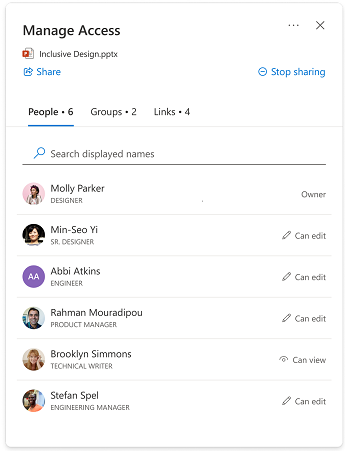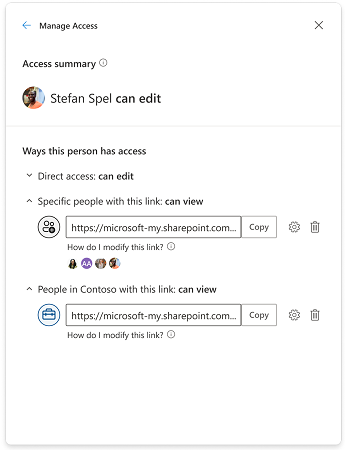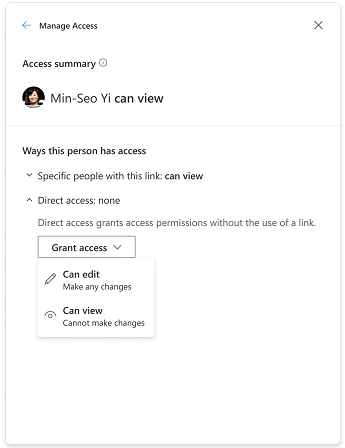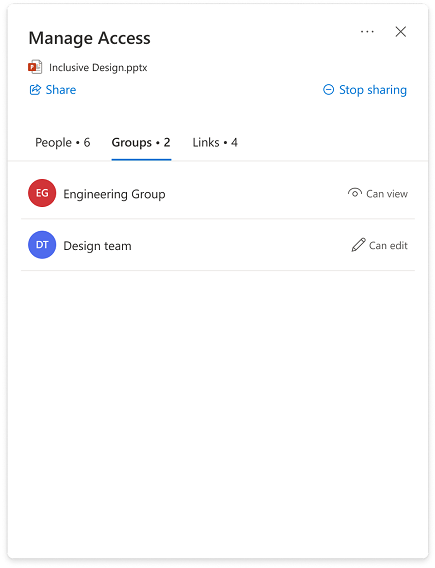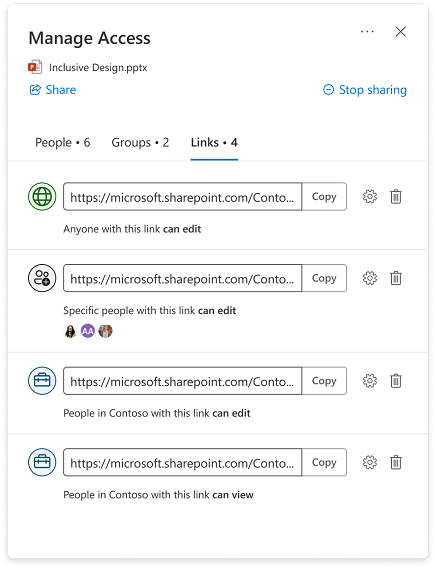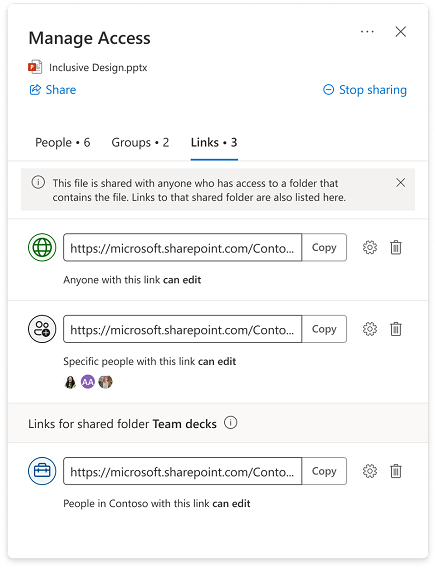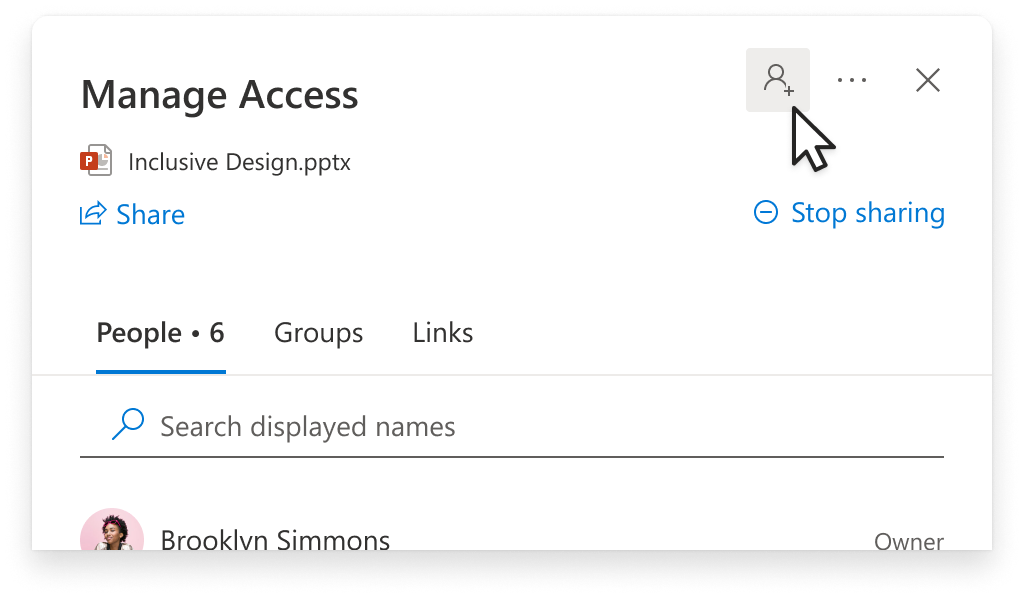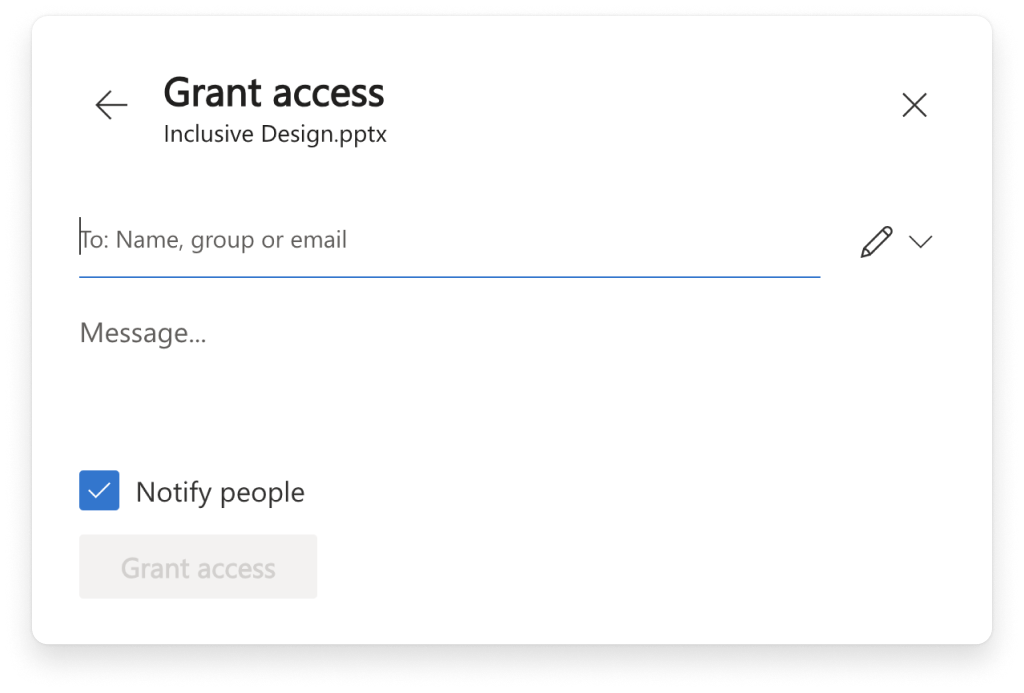People
This section shows the users that have access to your item. People can have access via a variety of means, including:
-
Someone shared a link with a person.
-
A person clicked on a sharing link that works for them (e.g. a member of your organization clicked on a link that only works for people in your organization)
-
A person was granted direct access.
Person's details
"Access summary" is a summary of what a person can do with the file or folder and shows the highest level of access that someone may have been given.
Note: if you share a link that gives someone "view only" permission, and then later send them a link that gives them "edit" access, the editing access will be the highest level of access they have, so it will show up in the access summary section.
"Ways this person has access" shows all the various ways that someone may have gained access to a file or folder. Exceptions include if they are part of a group with access, or if the person has access to a link to a folder that contains this particular item – this information will not show up in this section. Please check the "Groups" or "Links" view to see if either scenario may be giving someone additional access.
Direct Access
Users show up in Direct Access when they are listed directly on the item's permission, or ACL (Access Control List). The most common way for a user to be granted direct access is via "Grant Access" or via the advanced permissions page. When a user has direct access, you can modify their level of access directly by changing the permission or removing them entirely.
Changing permissions
Upgrade someone's access from "view only" to "edit": There are two ways you can upgrade someone's access to an item.
-
Share a new link with them with edit access.
-
Grant them direct access to edit.
Downgrade someone's access from "edit" to "view only": Depending on the means of access a user has, downgrading their access may take more steps.
If a user has edit access via a specific people link, you have two options:
-
Remove the user from the link and share a new link that only allows view access.
-
Delete the link altogether and share a new link that only allows view access. In the case where other people had access to the link, you may or may not want to share a new link with them as well, giving them the access you wish to give.
If a user has edit access via a company-shareable link, there is only one option.
-
Company shareable links will give access to anyone in the company that was given the link, so it is not possible for you to remove or block a coworker from accessing an item via this type of link. To downgrade their access, you must delete the link and share a new one that only allows view access. In the case where other people had access to the link, you may or may not want to share a new link with them as well, giving them the access, you wish to give.
Groups
If you share a file or folder with a group, the group will show up in this section. A member of the group won't show up in the ‘People' view (list of people) unless they have individually been given access separate from the group.
Changing permissions for groups follows the same steps as they do for people.
Links
Types of links:
-
Company shareable links
-
Specific people links
-
Anyone with this link
-
People with existing access
In most cases, link settings may not be changed once the link is created and shared. If you want to change the settings of a link, you must delete the link and create a new one with the settings you want. To learn more about sharing and link types, go here: Share OneDrive files and folders.
Note: If you want to remove the access of someone who is using a "Anyone with this link" link type, delete the link to remove access for everyone who has gained access via that link. Then, share a new link with anyone else whom you want to have access. We recommend using a specific people link if you'd like to manage their individual permissions and access later on.
Links for shared folders
-
The item you are managing access for may be located in a folder that was shared with a different audience than the item itself was shared with. In this case, the people who have access to any folder containing the item, by nature, will now have access to the item itself.
-
If the item itself wasn't shared directly with anyone who has access to any folders containing the item, those people will not sure up in the "People" view of the Manage Access experience for the individual item.
-
Links for the folders appear in the Manage Access experience for individual items that are within the folder and may be deleted in this experience.
Note: Deleting the link removes access to the folder and all the items within the folder for everyone who uses this link.
Grant access
-
Granting someone direct access to an item doesn't involve links or sharing settings. When someone has direct access, you can modify their level of access in Manage access by changing the permission or removing their access entirely.
-
Select
-
In the bottom left corner, select one of the profile images or initials icons, or the lock
-
In the top right corner, select the Grant access icon
-
Add a name, group, or email.
Note: You may add SharePoint groups that don't have associate emails, but the option to notify them will not be available.
-
To update the permission level for this person, to the right of the Name, group, or email area, select the permission icon (example: the edit icon
-
Select the type of permission you want to give this person for this item. Learn more about the levels of access.
-
Optionally, to notify the people you are sharing with, select the Notify people checkbox. When selected, the people you are sharing with will get an automated email from you to let them know they have access.
-
Select Grant access.
Email notifications for sharing links
If you share a document from your OneDrive with others, it can be helpful to know when they've taken some action on that file. You don't want to have to constantly check the file in hopes you can spot the changes.
To receive email notifications when the link you sent is clicked, follow these steps:
-
Open Manage Access under the Links tab.
-
Click on the gear icon next to the "People you specify" link type.
-
Add recipients in the "Specify people for this link" section and click "Apply". The recipients will automatically receive an email notification. Once they open the file, you will receive a confirmation email that they've opened the file successfully.
Note: The email notifications work for both internal and external users to your organization when using the "People you specify" link.
If a "People you specify" link has not been previously created, follow the steps to create a "People you choose" link, as described in the article:Sharing files, folders, and list items.

